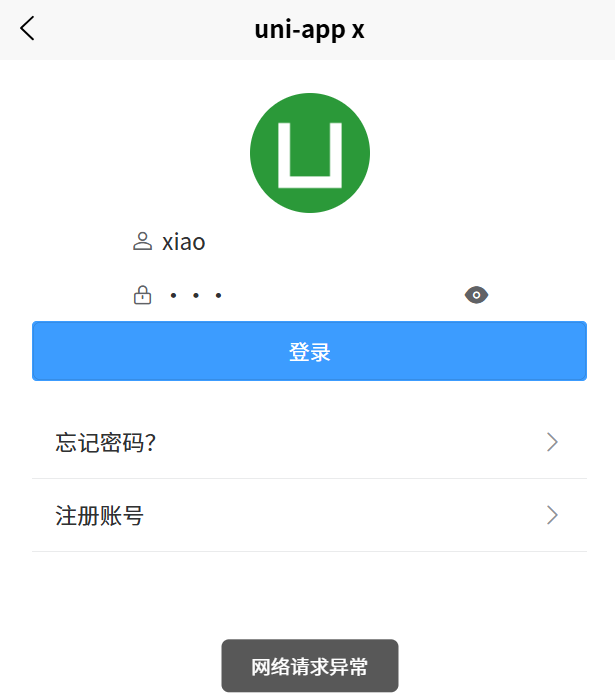uni-app x封装request,统一API接口请求
一、概述
uni-app x 提供了 uni.request() 方法。
uni.request({ url: 'https://api.example.com', method: 'GET' })
在实际项目开发中,直接使用 uni.request 会带来诸多问题,例如:
- 重复代码多(如每次都要写 baseURL)
- 错误处理分散,难以统一管理
- 缺乏请求/响应拦截能力
- Token 注入繁琐
- Loading 状态管理混乱
为了解决这些问题,封装一个统一的 HTTP 请求库是企业级开发的最佳实践。
二、封装request
uview-plus 自带一个 http 模块,但是在实际项目中,还是要自己封装一个,统一管理。
在项目根目录创建utils目录,在里面创建request.ts。 注意:文件后缀必须是ts,而不是js
// utils/request.ts import { http } from 'uview-plus' /* 1. 全局配置 */ http.setConfig((config) => { config.baseURL = 'https://api.example.com' // api地址 config.timeout = 8000 // 单位毫秒,对应8秒 config.loadingText = '加载中...' config.loading = true // 开启 loading 动画 return config }) /* 2. 请求拦截 */ http.interceptors.request.use((config) => { const token = uni.getStorageSync('token') if (token) config.header.Authorization = `Bearer ${token}` return config }) /* 3. 响应拦截 */ http.interceptors.response.use( (response) => response.data, (err) => { // 🔥 强制断言,让 UTS 闭嘴 (uni as any).$u.toast(err.message || '网络错误') return Promise.reject(err) } ) export default http
修改 main.uts,引入 request,并挂载为全局属性$http
import App from './App.uvue' import { createSSRApp } from 'vue' import uviewPlus from 'uview-plus' /* 1. 引入 request(里面已经初始化好 http) */ import http from '@/utils/request' export function createApp() { const app = createSSRApp(App) /* 2. 挂到全局属性 */ app.config.globalProperties.$http = http app.use(uviewPlus) return { app } }
三、使用request
由于在main.uts挂载了全局属性,因此在pages里面的uvue文件,就可以直接调用了。比如:
get请求
const res = await this.$http.get('/test', {})
post请求
const res = await this.$http.post('/login', { username: 'admin', password: 123456 })
post请求,增加成功和失败处理
async login() { try { /* === 成功分支 === */ const res = await this.$http.post('/login', { username: 'admin', password: '123456' }) // 这里只写“成功后的业务” uni.setStorageSync('token', res.token) this.$u.toast('登录成功') uni.switchTab({ url: '/pages/index/index' }) } catch (err: any) { /* === 失败分支 === */ // 拦截器已弹通用提示,这里可做“额外”处理 console.error('登录失败', err) if (err.statusCode === 401) { this.$u.toast('账号或密码错误') } } }
post请求,局部请求不想显示 loading
await this.$http.post('/log', data, { loading: false })
uview-plus 的 http 模块已经内置了 “请求开始自动显示 loading,响应结束自动隐藏” 的机制,
你只需要 把 loading 开关打开 即可,成功/失败/超时都会 统一自动关闭,无需手动处理。
效果:
调用 this.$http.get/post 瞬间 → 出现 uview-plus 的 loading 遮罩
请求 成功/失败/超时 → 遮罩 自动消失(由 uview 内部 finally 关闭)
无需自己 uni.showLoading() / uni.hideLoading()
post请求,增加header
await this.$http.post('/upload', body, { header: { 'Content-Type': 'application/x-wwwz-form-urlencoded', 'X-Custom': 'abc123' } })
put请求
const res = await this.$http.put('/test', {id:1})
delete请求
const res = await this.$http.delete('/test', {id:1})
四、登录页面
login.uvue
<template>
<view class="">
<!-- 导航栏 -->
<u-navbar title="用户登录" />
<!-- 内容区 -->
<view class="content">
<!-- 头像 -->
<u-avatar :src="logo" size="80"></u-avatar>
<!-- 表单 -->
<u--form :model="form" labelPosition="left">
<u--input v-model="form.username" placeholder="请输入用户名" prefixIcon="account" />
<u--input v-model="form.password" placeholder="请输入密码" type="password" prefixIcon="lock" />
</u--form>
<!-- 按钮 -->
<u-button text="登录" type="primary" @click="login" />
<!-- 链接 -->
<view class="links">
<u-cell title="忘记密码?" isLink @click="gotoForget" />
<u-cell title="注册账号" isLink @click="gotoRegister" />
</view>
</view>
</view>
</template>
<script>
export default {
data() {
return {
title: 'Hello',
logo: '/static/logo.png',
form: {
username: '',
password: '',
}
}
},
onLoad() {
},
methods: {
async login() {
if (!this.form.username) {
uni.showToast({ title: '请输入用户名', icon: 'none' })
return
}
// 请求登录接口
try {
/* === 成功分支 === */
const res = await this.$http.post('/login', {
username: this.form.username,
password: this.form.password
})
// 这里只写“成功后的业务”
uni.setStorageSync('token', res.token)
this.$u.toast('登录成功')
uni.switchTab({ url: '/pages/index/index' })
} catch (err : any) {
/* === 失败分支 === */
// 拦截器已弹通用提示,这里可做“额外”处理
console.error('登录失败', err)
if (err.statusCode === 401) {
this.$u.toast('账号或密码错误')
}
this.$u.toast('网络请求异常')
}
},
gotoForget() {
uni.navigateTo({ url: '/pages/forget/index' })
},
gotoRegister() {
uni.navigateTo({ url: '/pages/register/index' })
}
}
}
</script>
<style scoped>
.content {
padding: 40rpx;
display: flex;
flex-direction: column;
align-items: center;
}
.links {
margin-top: 30rpx;
width: 100%;
}
</style>
效果如下:

针对大型项目,可以在utils里面新建一个api.ts,用来编写一些公用业务函数,例如:
import http from './request.js' /* 登录 */ export const login = (username, pwd) => http.post('/login', { username, pwd }) /* 轮播图 */ export const getBanner = () => http.get('/banner') /* 商品列表 */ export const getGoods = (params) => http.get('/goods', { params })
然后在pages里面的页面,就可以调用了,无需重复写函数。
<script> import { getBanner } from '@/utils/api.ts' export default { data() { return { title: 'Hello', bannerList: [], } }, onLoad() { this.getbannerList() }, methods: { async getbannerList() { /* 直接调用 */ this.bannerList = await getBanner() }, } } </script>
注意:直接调用,要用异步,函数名前面加async


 浙公网安备 33010602011771号
浙公网安备 33010602011771号